The ECZ Luminous (JNM-ECZL series) is an FT NMR spectrometer that incorporates advanced digital and high-frequency technologies. The spectrometer's high reliability and further miniaturization are made possible by the Smart Transceiver System, a high-speed, high-precision digital high-frequency control circuit.
It can perform solid-state and high-field NMR measurements while keeping the same size as a typical low-field solution NMR system.
Multi-nuclei pulse trains can be operated on a single physical radio frequency channel using the new Multi Frequency Drive System. This makes it possible to perform sophisticated modern NMR experiments on a spectrometer with a very basic setup.
This series is regularly available for JEOL-made spectrometers of all NMR frequencies.
Key Features
MFDS (Multi Frequency Drive System)
JEOL has created a brand-new multi-frequency drive system. The ECZ Luminous system, which builds upon the ECZ system's design concept, allows for multiple resonance measurements on a typical two-channel spectrometer using triple-resonance probes such as HCN and HCX probes.
This makes it possible to use a reasonably basic and affordable NMR system to conduct intricate multi-nuclei experiments.
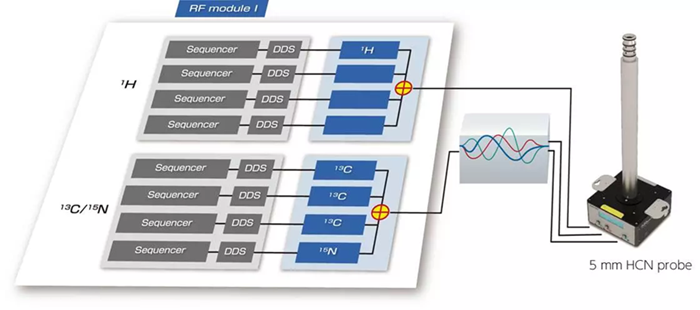
5 mm HCN probe configuration with ECZ Luminous System. Image Credit: JEOL USA, Inc.
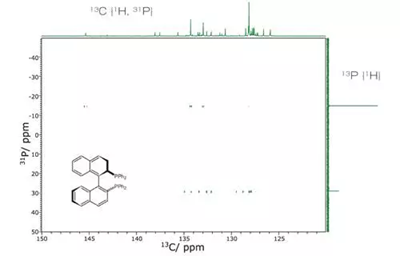
HCP triple resonance experiment performed by 2-channel spectrometer (13C-31P {1H} correlation). Image Credit: JEOL USA, Inc.
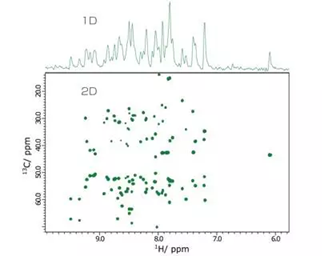
HCN triple resonance experiment performed by 2-channel spectrometer (CBCACONH). Image Credit: JEOL USA, Inc.
STS (Smart Transceiver System)
The STS (Smart Transceiver System) digital high integration and high frequency technology from the previous ECZ series is carried over into the ECZ Luminous. A single RF (Radio Frequency) transmitter/receiver board houses the sequencer, DDS (Direct Digital Synthesizer), FSU (Frequency Synthesizer Unit), transmitter, receiver, acquisition unit, and gate control unit.
A single RF transmitter/receiver board is configured with two 4-frequency source units (one for HF and one for LF) and one receiver. There are eight frequency sources and one receiver in the typical setup. Up to eight nuclei, 32-frequency sources, and four receivers can be supported by expanding the ECZ Luminous to four RF transmitter/receiver boards.
The STS's transmitter/receiver system combines superheterodyne undersampling and direct conversion oversampling technologies, enabling flexible frequency conversion and effective and ideal signal transmission/reception based on the target frequency.

Image Credit: JEOL USA, Inc.
Highly Precise Digital Control
With a minimum control time resolution of 5 ns, the ECZ Luminous sequencer offers quick control over frequency, phase, and amplitude modulation. The ECZ Luminous has a digital quadrature detection (DQD) circuit that allows for synchronous or asynchronous dynamic frequency and phase modulation in the transmitter and receiver systems.
Advanced solid-state NMR measurements, which have grown in significance in recent years, are anticipated to benefit from this since it permits signal processing with high functionality and a high degree of freedom. A special streaming transfer technology is employed for the quasi-infinite memory capacity of the sequence memory.
Various gating and synchronization operations with external systems are simultaneously provided with the same control performance. These high-speed, high-accuracy digital control technologies offer the best solution for a wide range of requirements, including achieving a wide range of advanced NMR measurements.
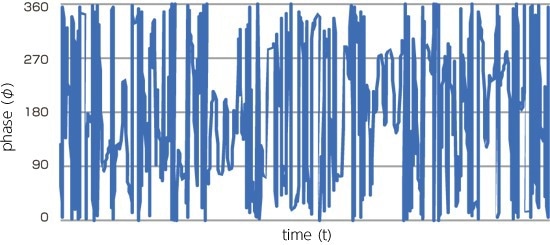
PM-BEBOP180 Phase modulated pulse. Image Credit: JEOL USA, Inc.
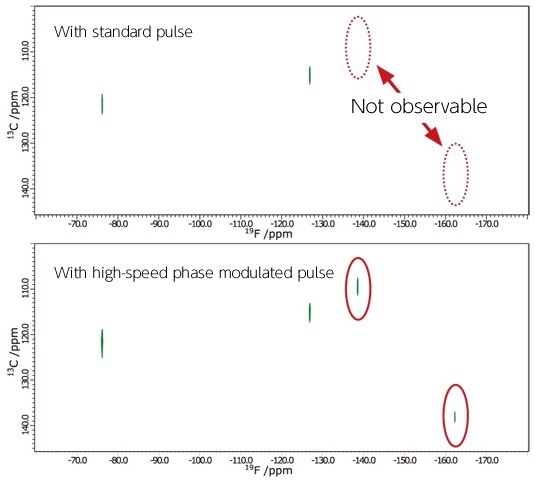
1H decoupled 19F-13C HMQC 2D spectrum. Image Credit: JEOL USA, Inc.
Wide Dynamic Range
In the presence of strong NMR signals (such as a residual solvent signal), small NMR signals can be captured in NMR spectra, thanks to ECZ Luminous's high dynamic range.
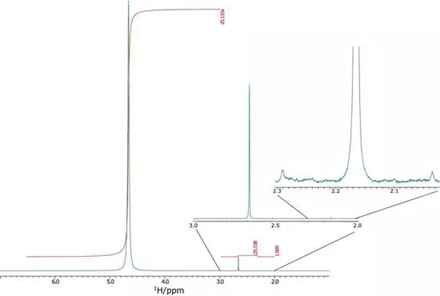
A small 13C satellite signal (about 4.6 millionths) of the acetone signal in a mixed sample: H2O:DMSO: Acetone=25131:125:1 (about 10% D2O) is clearly visible. Image Credit: JEOL USA, Inc.
Low-Noise Preamplifiers
Recently developed low-noise preamplifiers increase sensitivity. The sensitivity may be increased by roughly 10% when used in conjunction with ROYALPROBET™ / ROYALPROBE™ HFX.
Digital Lock Circuit for Stability
Using STS technology, the ECZ Luminous digitally controls the 2H lock with great speed and accuracy. The effects of magnetic field fluctuations are more effectively suppressed by the digital feedback circuit's superior response control. Stable and extended measurement is made possible by the digital lock feedback function's high speed and high precision.
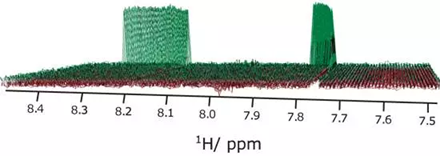
Stability test data over 12 hours 1D1H-13C HMQC needs to observe the correlated signal (left and right signals) of 13C-coupled 1H, which has an existence ratio of about 1%, and eliminate the directly observed signal of 12C-coupled 1H, which has an existence ratio of about 99%. This is why it is used to check stability. Image Credit: JEOL USA, Inc.
Easy Shimming
Better shim sets are a feature of ECZ Luminous. Compared to ECZ systems, automated 1D and 3D gradient shimming routines now operate much faster. This enhances NMR measurements at high throughput.
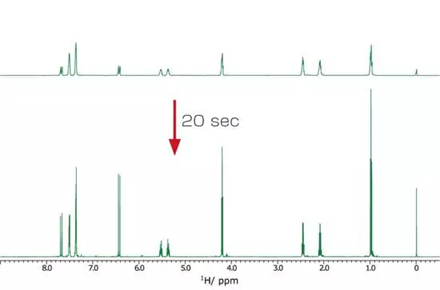
Gradient shimming (2H) Spectra before and after resolution adjustment by gradient shim. The resolution is improved by 20 seconds. Image Credit: JEOL USA, Inc.
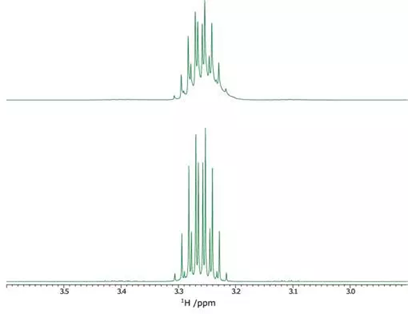
Gradient shimming (19F) You can select the 19F signal and use it to adjust the resolution with gradient shimming as well as the 2H signal. Image Credit: JEOL USA, Inc.
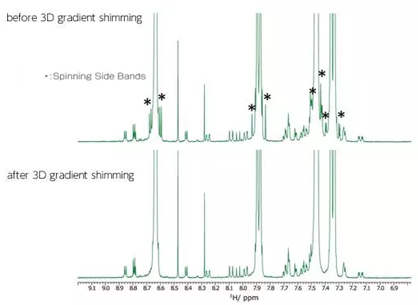
Poorly adjusted radial shims under sample rotation (top) and corrected with 3D gradient shimming (bottom). Image Credit: JEOL USA, Inc.
Specifications
More Compact Spectrometer
ECZ Luminous has improved the spectrometer's performance while achieving a notable size reduction. The R series' volume is now only around one-third that of its traditional counterpart.
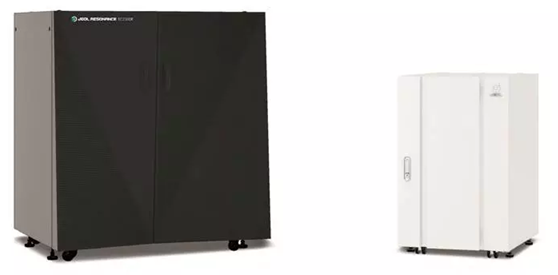
Size comparison with conventional models with equivalent performance. Image Credit: JEOL USA, Inc.
Specifications
Source: JEOL USA, Inc.
| |
JNM-ECZL G series |
JNM-ECZL R series |
JNM-ECZL S series |
| Frequency |
400 MHz - 1.3 GHz |
400 MHz - 600 MHz |
400 MHz |
| Sample type |
Solution / Solid |
Solution / Solid |
Solution |
| Number of channels |
2 (standard) |
2 |
2 |
| Power amplifier |
100 W (standard) |
100 W |
50 W |
| High frequency |
200/500/1000 W (as optional) |
|
|
| Power amplifier |
300 W (standard) |
300 W |
150 W |
| Low frequency |
500/1000/2000 W (as optional) |
|
|
| Magnetic field gradient amplifier |
10 A (standard) |
10 A |
10 A |
| 30/50 A (as optional) |
|
|
| Console size [W × D × H] |
600 × 855 × 1279 mm |
536 × 730 × 855 mm |
536 × 730 × 855 mm |
Lineup
Three distinct models of ECZ Luminous are offered to accommodate a broad range of user needs. High-performance digital high-frequency technology and intuitive Delta software are features found in all models.
JNM-ECZL G Series
One flagship model for state-of-the-art NMR techniques is the ECZL G series. The spectrometer's footprint has been lowered to less than 60% of ECZR while preserving the expandability required to accommodate a variety of applications.
Even when installed in the bare minimum configuration, it can be expanded in the future, due to its support for three or more channels, high-power amplifiers, and high-output magnetic field gradients. It is a flexible FT-NMR system that can react to new applications and modifications in user applications.
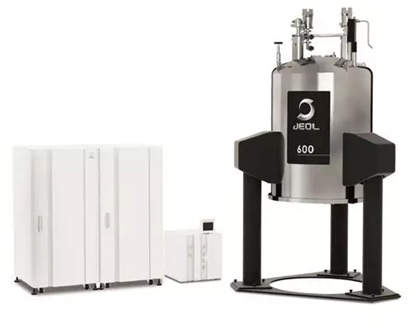
Dual rack configuration. Image Credit: JEOL USA, Inc.
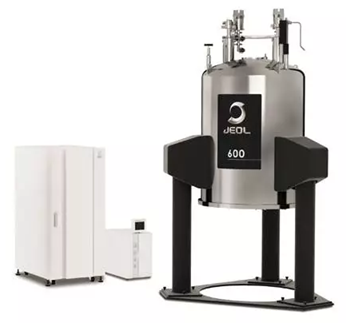
Image Credit: JEOL USA, Inc.
JNM-ECZL R Series
Compact spectrometers of the ECZL R series can detect magnetic fields as high as 600 MHz. It can also be used for solid-state measurements, and its footprint is less than half that of ECZR.
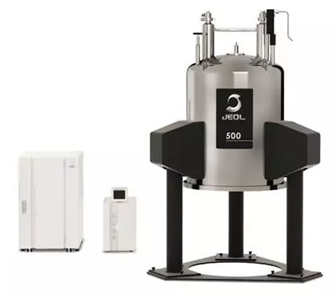
Image Credit: JEOL USA, Inc.
JNM-ECZL S Series
The ECZL S series is a simplified model that incorporates the high-performance digital high-frequency technology of the ECZL series and is devoted to 400 MHz state-of-the-art NMR.
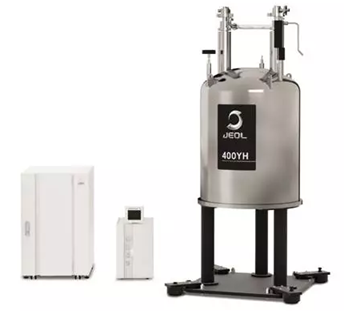
Image Credit: JEOL USA, Inc.